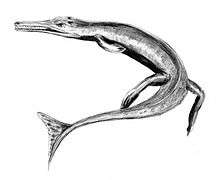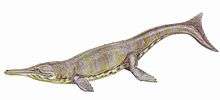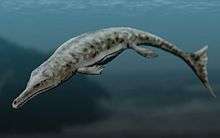Metriorhynchidae
| Metriorhynchidae Temporal range: Middle Jurassic-Early Cretaceous, 170–125 Ma | |
|---|---|
| | |
| Dakosaurus maximus skull, Staatliches Museum für Naturkunde Stuttgart | |
| Scientific classification | |
| Kingdom: | Animalia |
| Phylum: | Chordata |
| Class: | Reptilia |
| Superorder: | Crocodylomorpha |
| Suborder: | †Thalattosuchia |
| Superfamily: | †Metriorhynchoidea |
| Family: | †Metriorhynchidae Fitzinger, 1843 |
| Subfamilies | |
| Synonyms | |
Metriorhynchidae is an extinct family of metriorhynchoid crocodyliforms from the Middle Jurassic to the Early Cretaceous period (Bajocian - Valanginian stages) of Europe, North America and South America. Metriorhynchids are fully aquatic crocodyliforms. Their forelimbs were small and paddle-like, and unlike living crocodilians, they lost their osteoderms ("armour scutes"). Their body shape maximised hydrodynamy (swimming efficiency), as did having a shark-like tail fin.[3]
Metriorhynchids were the only group of archosaurs (aside from seabirds) to become fully adapted to the marine realm, becoming pelagic in lifestyle.[4]
The name Metriorhynchidae was coined by the Austrian zoologist Leopold Fitzinger in 1843.[5] It contains two subfamilies, the Metriorhynchinae and the Geosaurinae.[6][7]
Geographical distribution
The family has a wide geographic distribution, with material found in Argentina, Chile, Cuba, England, France, Germany, Italy, Mexico, Poland, Russia and Switzerland.[4][7]
Classification
Phylogenetic analyses published during the 2000s cast doubt on the idea that many traditional metriorhynchid genera formed natural groups (i.e., include all descendants of a common ancestor). The traditional species of Geosaurus,[8][9][10] Dakosaurus[8] and Cricosaurus[8] were found to represent unnatural groups, and the species traditionally classified in these genera were reshuffled in a study published in November 2009 by Mark T. Young and Marco Brandalise de Andrade.[6] The monophyly of Metriorhynchus [8][9][11] and Teleidosaurus[8][10] is also unsupported, and the species of these genera are pending reclassification.[6]
The classification presented by Young and Andrade in 2009 was approved in later studies of the Metriorhynchidae.[7][12][13] Metriorhynchidae is a node-based taxon defined in 2009 as the least inclusive clade consisting of Metriorhynchus geoffroyii and Geosaurus giganteus.[6] The cladogram below follows the topology from a 2011 analysis by Andrea Cau and Federico Fanti with clade names from Young et al. 2011 and reduced to genera only.[7][12]
| Metriorhynchidae |
| ||||||||||||||||||||||||||||||||||||||||||||||||||||||||||||||||||
| |
List of genera
The type genus of the family Metriorhynchidae is Metriorhynchus from the Middle to Late Jurassic.[4] Other genera included within this family are Cricosaurus, Geosaurus, and Dakosaurus. Though once considered a metriorhynchid, Teleidosaurus has since been found to be slightly more distantly related to these animals within the superfamily Metriorhynchoidea.
Within this family, the genus Neustosaurus is considered nomen dubium ("doubtful name").[14]
The genus Capelliniosuchus was once thought to be a metriorhynchid similar to Dakosaurus.[15] However, Sirotti demonstrated that it is a junior synonym of Mosasaurus.[16]
| Genus | Status | Author | Age | Location | Description | Synonyms | Images |
|---|---|---|---|---|---|---|---|
| Ambayrac, 1913 | late Oxfordian |
France. |
Sometimes considered to be a nomen dubium. |
| |||
| Valid | Wagner, 1858 | middle Oxfordian to upper Valanginian |
Argentina, Chile, Cuba, England, France, Germany, Mexico, Russia and Switzerland. |
| |||
| Valid | von Quenstedt, 1856 | lower Oxfordian to lower Berriasian |
Argentina, England, France, Germany, Mexico, Poland, Switzerland and possibly Russia. |
| |||
| Valid | Cuvier, 1824 | upper Kimmeridgian to upper Valanginian |
France, Germany, Italy and Switzerland. |
| |||
| Valid | Young et al., 2010 | lower Kimmeridgian |
England and France. |
||||
| Valid | Parrilla-Bel et al., 2013 |
Spain. |
|||||
| Valid | von Meyer, 1830 | lower Callovian to upper Kimmeridgian. |
England, France, Germany and Switzerland. |
| |||
| Valid | Cau & Fanti, 2011 | late Bajocian to earliest Bathonian |
Italy. |
||||
| nomen dubium | — potential senior synonym of Cricosaurus | ||||||
| Valid | Owen, 1884 | late Kimmeridgian to early Tithonian |
England and possibly Spain. |
||||
| Valid | Rusconi, 1948 | lower Callovian to lower Tithonian |
Argentina and Chile. |
||||
| Valid | von Meyer, 1831 | lower Tithonian |
Germany. |
||||
| Valid | Lydekker, 1890 | lower Callovian to lower Oxfordian |
England and France. |
||||
| Valid | Andrade et al., 2010 | upper Kimmeridgian |
England. |
||||
| Valid | Young et al., 2013 |
England. |
See also
References
- ↑ Alfio A. Chiarenza, Davide Foffa, Mark T. Young, Gianni Insacco, Andrea Cau, Giorgio Carnevale, Rita Catanzariti (2015). "The youngest record of metriorhynchid crocodylomorphs, with implications for the extinction of Thalattosuchia". Cretaceous Research. 56: 608–616. doi:10.1016/j.cretres.2015.07.001.
- ↑ Andrews CW. 1913. A descriptive catalogue of the marine reptiles of the Oxford Clay, Part Two. London: British Museum (Natural History), 206 pp.
- ↑ Fraas E. 1902. Die Meer-Krocodilier (Thalattosuchia) des oberen Jura unter specieller Berücksichtigung von Dacosaurus und Geosaurus. Paleontographica 49: 1-72.
- 1 2 3 Steel R. 1973. Crocodylia. Handbuch der Paläoherpetologie, Teil 16. Stuttgart: Gustav Fischer Verlag,116 pp.
- ↑ Fitzinger LJFJ. 1843. Systema Reptilium. Wien: Braumüller et Seidel, 106 pp.
- 1 2 3 4 Mark T. Young and Marco Brandalise de Andrade (2009). "What is Geosaurus? Redescription of Geosaurus giganteus (Thalattosuchia: Metriorhynchidae) from the Upper Jurassic of Bayern, Germany". Zoological Journal of the Linnean Society. 157 (3): 551–585. doi:10.1111/j.1096-3642.2009.00536.x.
- 1 2 3 4 Mark T. Young, Stephen L. Brusatte, Marcello Ruta and Marco Brandalise de Andrade (2010). "The evolution of Metriorhynchoidea (Mesoeucrocodylia, Thalattosuchia): an integrated approach using geometrics morphometrics, analysis of disparity and biomechanics". Zoological Journal of the Linnean Society. 158 (4): 801–859. doi:10.1111/j.1096-3642.2009.00571.x.
- 1 2 3 4 5 Young MT. 2007. The evolution and interrelationships of Metriorhynchidae (Crocodyliformes, Thalattosuchia). Journal of Vertebrate Paleontology 27 (3): 170A.
- 1 2 Wilkinson LE, Young MT, Benton MJ. 2008. A new metriorhynchid crocodilian (Mesoeucrocodylia: Thalattosuchia) from the Kimmeridgian (Upper Jurassic) of Wiltshire, UK. Palaeontology 51 (6): 1307-1333.
- 1 2 Mueller-Töwe IJ. 2005. Phylogenetic relationships of the Thalattosuchia. Zitteliana A45: 211–213.
- ↑ Gasparini Z, Pol D, Spalletti LA. 2006. An unusual marine crocodyliform from the Jurassic-Cretaceous boundary of Patagonia. Science 311: 70-73.
- 1 2 3 Andrea Cau; Federico Fanti (2011). "The oldest known metriorhynchid crocodylian from the Middle Jurassic of North-eastern Italy: Neptunidraco ammoniticus gen. et sp. nov.". Gondwana Research. 19 (2): 550–565. doi:10.1016/j.gr.2010.07.007.
- ↑ Mark T. Young, Mark A. Bell and Stephen L. Brusatte (2011). "Craniofacial form and function in Metriorhynchidae (Crocodylomorpha: Thalattosuchia): modelling phenotypic evolution with maximum-likelihood methods". Biology Letters. 7 (6): 913–916. doi:10.1098/rsbl.2011.0357.
- ↑ Buffetaut, E. 1982. Radiation évolutive, paléoécologie et biogéographie des Crocodiliens mésosuchienes. Mémoires Societé Geologique de France 142: 1–88.
- ↑ Simonelli V. 1896. Intoro agli avanzi di coccodrilliano scoperti a San Valentino (provincial di Reggio Emilia) nel 1886. Atli della Reale Accademia dei Lincei, series Qunita Rendiconti 5 (2): 11-18.
- ↑ Sirotti A. 1989. Mosasaurus hoffmanni Mantell, 1828 (Reptilia) nelle <<argille scagliose>> di S. Valentino (Reggio E.). Atti della società dei naturalisti e matematici di Modena 120: 135-146.
- ↑ Koken E. 1883. Die reptilian der norddeutschen unteren Kreide. Zeitschrift deutschen Geologischen Gesellschaft 35: 735-827.
- ↑ Quenstedt FA. 1856. Sonst und Jetzt: Populäre Vortäge über Geologie. Tübingen: Laupp, 131.
- ↑ Cuvier G. 1824. Sur les ossements fossiles de crocodiles, 5. In: Dufour & D'Occagne, eds. Recherches sur les ossements fossiles, 2nd édition. Paris: 143-160
- ↑ Young, Mark T., Brusatte, Stephen L., Ruta, M., Andrade, Marco B. 2009. "The evolution of Metriorhynchoidea (Mesoeucrocodylia, Thalattosuchia): an integrated approach using geometrics morphometrics, analysis of disparity and biomechanics". Zoological Journal of the Linnean Society 158: 801-859.
- ↑ Meyer H Von. 1830. Achte Versammlung der Naturforscher und Aerzte zu Heidelberg im September 1829. Isis von Oken, 1830: 517-519.
- ↑ Andrade, M.B.D.; Young, M.T.; Desojo, J.B.; Brusatte, S.L. (2010). "The evolution of extreme hypercarnivory in Metriorhynchidae (Mesoeucrocodylia: Thalattosuchia) based on evidence from microscopic denticle morphology". Journal of Vertebrate Paleontology. 30 (5): 1451–1465. doi:10.1080/02724634.2010.501442.





